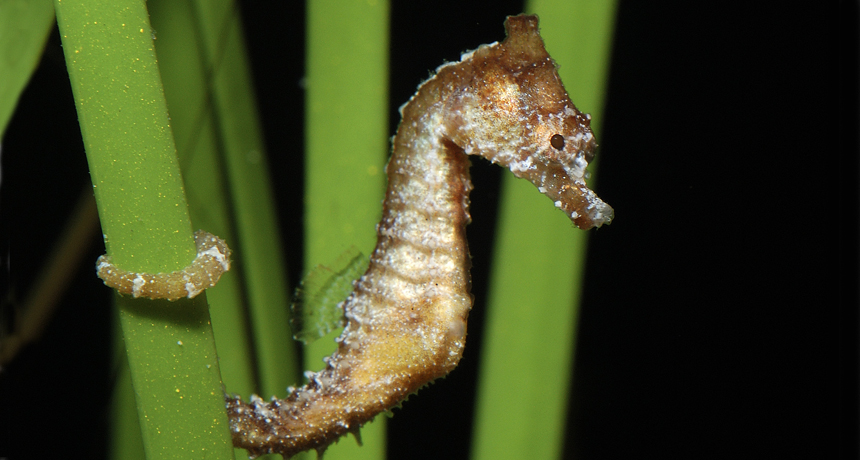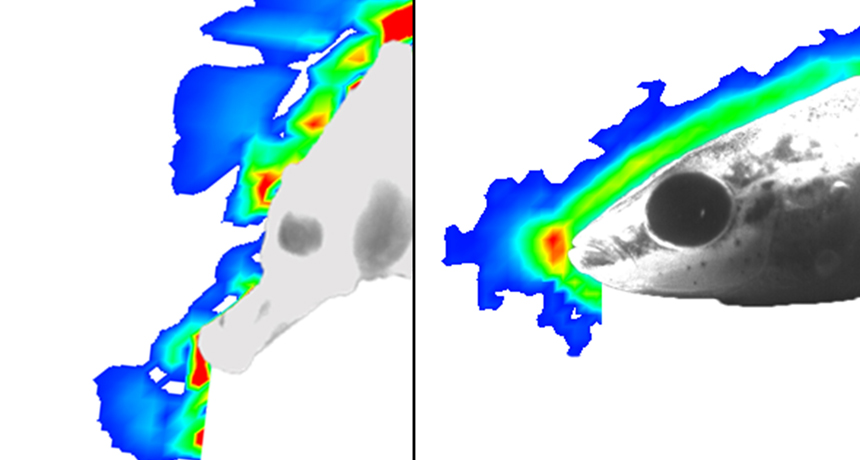
PRETTY LITTLE SNEAKER The head shape of a dwarf seahorse (Hippocampus zosterae) helps it sneak up on very jumpy prey.
Gregory G. Dimijian/Science Source
A dwarf seahorse can sneak unnoticed remarkably close to prey — less than a penny’s thickness away — thanks to the way the horsey head shape moves through water.
If they had just two or three milliseconds of warning, some of the seahorse’s prime prey, tiny crustaceans called copepods, would scoot away, says Brad Gemmell of the University of Texas at Austin. But a dwarf seahorse (Hippocampus zosterae) can strike even faster, within one millisecond. To succeed with its speedy strike, the seahorse somehow has to get within about a millimeter of its prey.
New imaging reveals a seahorse trick. As its head nears the prey, a zone of water above the front of the tip of its snout stays calm, Gemmell and his colleagues report November 26 in Nature Communications. The trick fools copepods, which rely on antenna hairs to pick up the incoming whoosh of water in front of an attacking predator.

Ironically, dwarf seahorses are some of the slowest-swimming fish known, yet they can feed on “one of the most capable escape artists on the planet,” Gemmell says.
Copepods can shoot away from danger at about 500 body lengths per second – far faster, relatively, than a cheetah, which runs about 20 to 30 body lengths per second. The tiny crustaceans, only a millimeter or two long, cover much less distance; but in their world, millimeters matter.
Copepods and seahorses are engaged in “an arms race,” says Sam Van Wassenbergh of Ghent University in Belgium. Copepod power to escape danger does battle with the approach tactics of the seahorse. And with such short snouts, dwarf seahorses need to get closer to their prey than longer-snouted species before they reach out to strike.
Water flow on the battleground gives copepods an advantage. Both dwarf seahorses and Acartia tonsa copepods live in seagrass meadows undulating along the bottom of the Gulf of Mexico and the Caribbean Sea. Seagrass dampens water turbulence, so copepods easily pick out the anomalies if water rushes at them from any attackers.
Fish other than seahorses manage to catch the twitchy crustaceans in calm water in only about one strike out of three. However, Gemmell says, a dwarf seahorse within striking range succeeds 94 percent of the time.
“I couldn’t do that,” says Gemmell, even after much experience chasing copepods around lab dishes with a pipette. To figure out the seahorse secret, he and his colleagues used a 3-D holography imaging technique based on shining a low-power laser beam at striking animals. Analyzing how the water moved as seahorses skulked toward prey revealed the dangerously calm spot just off the tops of snouts.
The spot showed up even when researchers moved a dead seahorse through the water. It’s the shape of the head and not something the seahorse is doing that creates the spot, the researchers concluded.
However it forms, this zone of deadly calm develops in the right location for the signature seahorse strike. Called pivot feeders, seahorses let fly a sudden strike with the head pivoting upward. “Once a seahorse is in range, the copepod doesn’t have a chance,” Gemmell says.
Editor’s Note: This story was updated on December 5, 2013, to clarify that the catch rates mentioned are in calm water.
ATTACK OF THE STEALTH SEAHORSE In high-speed video shown slowed down, a dwarf seahorse closes in for a lightning strike on skittish copepods, known for their quick darts away from danger.
Credit: Brad Gemmell





